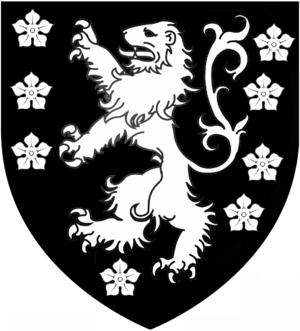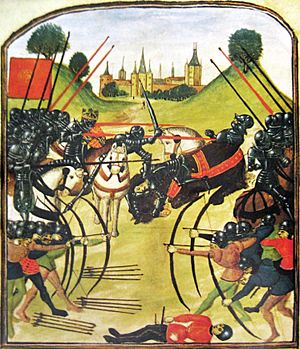Gervase Clifton (died 1471) facts for kids
Quick facts for kids
Sir Gervase Clifton
|
|
|---|---|

Arms of Clifton of Clifton, Nottinghamshire (later arms of Clifton baronets (1611) and Baron Clifton (1608) of Leighton Bromswold): Sable semée of cinquefoils and a lion rampant argent
|
|
| Died | 6 May 1471 Tewkesbury |
| Buried | Brabourne, Kent |
| Noble family | Clifton |
| Spouse(s) | Isabel Vincent (alias Finche) Maud Stanhope |
| Issue | Isabel Clifton Joan Clifton |
| Father | Sir Gervase Clifton |
| Mother | Isabel Fraunceys |

Sir Gervase Clifton (died 6 May 1471) was an important English knight and landowner in the 1400s. He lived during a time of great change in England, known as the Wars of the Roses. Sir Gervase was a supporter of King Henry VI. Sadly, he was executed after a major battle called the Battle of Tewkesbury.
Contents
Early Life and Family
Gervase Clifton was born into a well-known family from Nottinghamshire, England. His father was also named Sir Gervase Clifton. His mother was Isabel Fraunceys. The Clifton family had been important in the area since the 11th century. They were a junior branch of the Clifton family of Nottinghamshire.
Sir Gervase's Career
Sir Gervase Clifton had an active career in public service. He held several important positions.
Serving the King
He worked as the Lieutenant of Dover Castle, which was a very important fortress. He also served as the Treasurer of Calais from 1450 to 1460. Calais was an English town in France at that time. For a short period, he was even the Treasurer of the Household for King Henry VI. This meant he managed the king's money and expenses.
Local Leadership
Sir Gervase was also involved in local government. He became the Mayor of Canterbury in 1450. He served as the High Sheriff of Kent three times: in 1439, 1450, and 1458. A High Sheriff was a top law enforcement officer in a county. In 1455, he represented Kent in the English Parliament. This meant he helped make laws for the country.
The Wars of the Roses
Sir Gervase Clifton lived during the Wars of the Roses. This was a series of civil wars fought in England between two royal families: the House of Lancaster (who used a red rose as their symbol) and the House of York (who used a white rose). Sir Gervase supported the Lancastrian side, led by King Henry VI and his wife, Margaret of Anjou.
Because of his support for the Lancastrians, he was declared a traitor by the opposing side. He fought in the Battle of Tewkesbury in 1471. This was a very important battle in the Wars of the Roses. The Lancastrians lost the battle, and Sir Gervase was captured.
His Death
After the Battle of Tewkesbury, Sir Gervase Clifton was executed. He was beheaded in the market square of Tewkesbury on May 6, 1471. Many other Lancastrian leaders were also executed that day.
Family Life and Daughters
Sir Gervase Clifton was married twice. He did not have any sons, but he had two daughters from his first marriage. These daughters became his co-heiresses, meaning they inherited his property.
First Marriage
His first wife was Isabel Herbert. She had been married before. Sir Gervase and Isabel had two daughters:
- Isabel Clifton: She married John Jerningham in 1459. They had two sons and several daughters. One of their sons, Sir Edward Jerningham, became an important figure. Another son, Sir Richard Jerningham, worked for King Henry VIII. Their daughter, Margaret Jerningham, was the grandmother of Anne Seymour, Duchess of Somerset.
- Joan Clifton: She married John Digges. Their grandson was the famous scientist, Leonard Digges.
Second Marriage
Sir Gervase's second wife was Maud Stanhope. They married before March 1463. Maud had also been married twice before. She was related to some important noble families. Sir Gervase and Maud did not have any children together. Maud Stanhope died in 1497.

